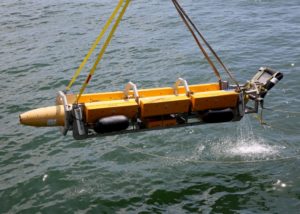ANNAPOLIS, Md. — A Navy official said the service’s Littoral Combat Ship (LCS)-based mine countermeasures (MCM) mission packages (MPs) needs help from industry to work the mission faster.
“What’s really the enemy? It’s time…I can never get you to guarantee there are no mines in the water, but given enough time I can pretty safely assure you that you can do what you need to do – but time is the enemy,” Capt. Chris Merwin, Director for Mine Warfare at the Surface and Mine Warfighting Development Center (SMWDC), said at a National Defense Industrial Association event here on Tuesday.

Typically, the Navy’s MCM mission does not have time to spare, “So I need to speed up that tempo.”
While the service is moving toward unmanned vessels based from LCSs and vessels of opportunity (VOO) “what I really need is…in-stride and over the horizon communications,” Merwin continued.
Currently MCM systems have sensors run missions, then return, and then personnel conduct post-mission analysis (PMA) looking at the “sonar waterfall” to pick out mines.
Merwin underscored currently there is typically a one-to-one comparison of mission vs. PMA time.
“We’ve got to get away from that. I need in-stride and over-the-horizon communications telling me, ‘Hey I think I’ve got something suspicious here, my sonar just saw something that looks different.’”
The Navy also wants automatic target recognition (ATR) needs to help the service figure out there is an anomaly and send the message to human operators right away and to improve data handling times so information can get from underwater sonars to operators more quickly.
Merwin said while the unmanned vessels in future MCM warfare are naturally more expendable, the service is looking for vessels that have better sensors and reduced sonar signatures to save as many as possible.
“They’re clearly in the minefield and they’re certainly expendable at some level, but we can’t have too many of the Mk 18s or too many of the Knifefish being the neutralizer, so reduced signatures for all those things absolutely would be helpful to us in the future.”
Current mine warfare trains and operates in pristine GPS environments but it will be “critical to mine warfare” to have that precision, navigation, timing and resilient communications in more denied situations.
Merwin confirmed that ultimately the Navy wants to get to single sorties detect-to-engage. Currently, only the legacy
Avenger-class vessels on schedule to retire can operate that way.
“I need a UUV that can go out, search, determine that it’s got something, that onboard AI/machine learning tells it’s got something, and then reacquire identification verify it right there, and then put a neutralizer on the spot. That’s the coin of the realm, that’s ultimately where we’re going.”
While Merwin admitted there has been some testing to that effect so far and it is not far from the realm of possibility, “that’s where we need to get to.”